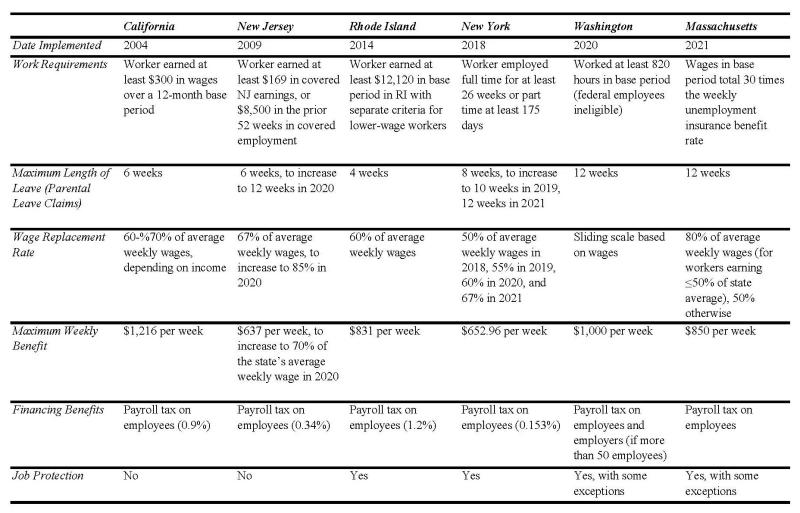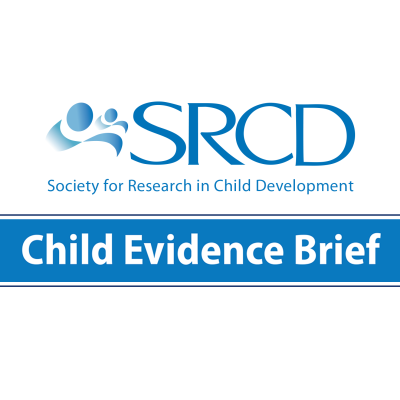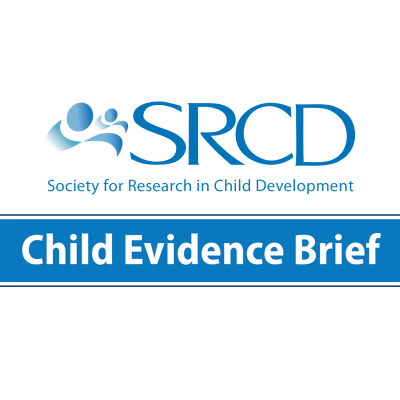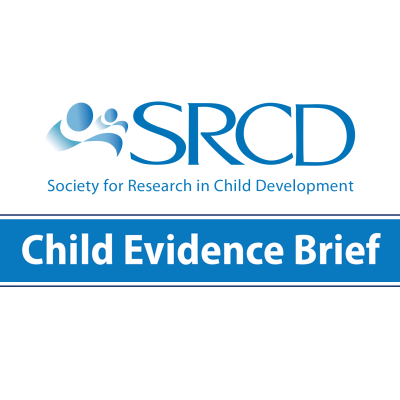Paid Family and Medical Leave Improves the Well-Being of Children and Families
Edited by Rebekah Levine Coley, Ph.D., Boston College. For more information, contact Kelly R. Fisher, Ph.D., Director for Policy, Society for Research in Child Development, at policy@srcd.org.
Authors
- Jane Waldfogel, School of Social Work, Columbia University
- Elizabeth Doran, School of Social Work, Columbia University
- Jessica Pac, School of Social Work, Columbia University
American families are changing. More children live with two working parents or a single working parent. At the other end of the life cycle, adults are living longer and working longer. These trends have increased the need for paid family and medical leave, which allows workers to fulfill important caregiving responsibilities without having to give up their paid employment. To address this need, seven states and the District of Columbia have enacted paid family and medical leave insurance laws, and many other states and the federal government have these programs on their legislative agendas. The evidence from these states and from other countries that have enacted paid leave laws strongly suggests that paid family and medical leave enhances families’ economic well-being; increases fathers’ engagement; and improves infant, child, and maternal health.
Most Individuals Need Paid Family or Medical Leave at Some Point in Their Lives
The need for paid family and medical leave is widespread. Nearly every worker will experience childbirth or a serious illness themselves or in their family at some point, requiring time off work. Almost half of working adults in the United States say they needed leave to care for a seriously ill family member or anticipate needing such leave in the future, and 10% say they needed leave but were unable to take it.1 In the absence of paid leave, the typical U.S. mother returns to work within three weeks after childbirth, and the typical father takes just one week off work.2,3
The need for leave has accelerated in recent decades because most American families no longer have a stay-at-home caregiver who can take care of a new child or a seriously ill family member.4,5 Children today are nearly twice as likely as were in 1967 to live in a household where both parents work.5 Balancing the competing needs of work and family is more difficult for single-parent families and low-income families.5,6 Paid family and medical leave policies have emerged as a potential solution to enable workers to provide needed care for their children and other family members while remaining in the workforce.
Paid Family and Medical Leave Laws Have Been Implemented Successfully
In the United States, the Family and Medical Leave Act (FMLA), which went into effect in 1994, provides jobprotected unpaid leave to about 60% of workers.7 Some workers (nearly 40%) have access to employer-sponsored paid family leave, with low-income, part-time, and Hispanic workers much less likely to be covered by such policies.8
In other countries, paid family and medical leave has long been provided as part of the social insurance system. On average, countries in the Organization for Economic Cooperation and Development provide nearly a year of paid parental leave, as well as paid medical and family care leave.
Although the United States currently lacks a federal paid family and medical leave insurance program, seven states and the District of Columbia have enacted paid family and medical leave laws, providing leaves of 4 to 12 weeks.9 Crucially, all the state programs are funded by payroll contributions by employees (or, in some instances, by employers) that go into a social insurance fund, so individuals who take leave and their employers do not have to pay directly for the leave. These programs replace a portion of employee wages (up to a maximum) for leaves that qualify, such as caring for a new child or one’s own or a family member’s serious illness. In 2004, California was the first state to implement a paid family and medical leave policy. In California, maternal leave claims grew from 50,000 (36.4% of new mothers) in 2004 to 125,000 (45.4%) in 2014. Although paternal claims are much less frequent, they increased proportionately more from 10,000 (4.4% of new fathers) in 2004 to 50,000 (8.9%) in 2014.(10) The law also covers leave for seriously ill family members; such claims are about a tenth as numerous as claims for parental leave.10
Paid Family and Medical Leave Policies for Children and Families Have Many Benefits
A large body of rigorous research has found that paid parental leave policies benefit mothers, fathers, and infants,11,12 leading to:
- Increased leave-taking by both mothers and fathers: Several studies examining the effects of California’s paid family leave found that leave-taking doubled among mothers, extending leave by an average of three weeks and longer among economically disadvantaged mothers. Among fathers, leave-taking increased 46% and was extended by an average of several days.2,3,13,14
- Improved economic well-being for families: Access to leave increased employment for both parents and earnings for mothers. For example, mothers’ wages rose 10% to 17%, and the number of hours and weeks worked also increased.2,3,13,14 More limited evidence found that paid leave may reduce families’ use of public assistance.15
- Improved maternal mental health: In one study, paid leave reduced symptoms of depression among mothers with infants by nearly 30%.16
- Prolonged breastfeeding: Gaining access to leave increased breastfeeding by up to 18 days, with much larger effects—up to 65 days—among economically disadvantaged mothers.17,18
- Increased engagement of fathers: Fathers with access to leave not only participated in more caregiving activities during the period of leave, but those who took leaves of two weeks or greater were more engaged with their children after the leave.19-21
- Reduced infant mortality and hospitalizations: Several studies found higher survival rates and more optimal health for infants under paid family leave laws, including reduced infant mortality and hospital admissions. Importantly, unpaid leave does not confer these benefits.22-27
- Reduced rates of children born pre-term or with low birth weight: Children whose mothers had access to paid leave were 6.6% less likely to be born pre-term, and 10% less likely to be underweight at birth.24-26
- Improved mental and physical health in childhood: Access to leave appeared to reduce the incidence of physical health conditions and ADHD, with notably larger effects for economically disadvantaged children.28,29
- Improved child safety: In one study in California, hospital admissions for abusive head trauma, an indicator of child maltreatment, declined relative to hospital admissions in states without paid leave.30
Caregivers, children, and elderly relatives also benefit from medical caregiving leaves:
- Children who are ill fare better when their parents stay home with them.31
- After California’s paid family leave policy went into effect, use of nursing homes for elderly relatives declined by 11%.32
- Women who did not have paid leave were less likely to return to work after caring for an elderly family member, implying that leave has a positive effect on employment for such caregivers.33
The effects of paid family leave are often larger among disadvantaged families, including for breastfeeding,18 infant health,22,25 school achievement,34 and overall rates of taking leave.3,13 Such results imply that paid family leave may help reduce economic and social inequalities.
Paid Family and Medical Leave Is Supported by the Public and by Employers
Beyond these benefits, paid leave has notable public support.1,35 According to a recent Pew Research Center study, 8 out of 10 Americans agree that mothers should have access to paid leave following the birth (or adoption) of a child, or for serious personal health conditions. Seven out of 10 support paid paternity leave or leave to care for seriously ill family members.1
These policies are also endorsed by employers. Surveys of employers in states with paid family and medical leave policies— focusing on small employers that are often missing from such surveys—reveal that two-thirds of employers are supportive.36,37
Table 1: Elements of State Paid Family Leave Policies (2018)

Note. Adapted from the National Conference of State Legislatures (http://www.ncsl.org/research/labor-and-employment/state-family-and-medical-leave-laws.aspx) and the Urban Institute (https://www.urban.org/sites/default/files/publication/90201/paid_family_leave_0.pdf)
Endnotes / References
(1) Horowitz, J., Parker, K., Graf, N., Livingston, G., & Rohal, M. (2017). Americans widely support paid family and medical leave, but differ over specific policies: Personal experiences with leave vary sharply by income. Washington, DC: Pew Research Center. Retrieved from www.pewresearch.org
(2) Bartel, A.P., Rossin-Slater, M., Ruhm, C.J., Stearns, J., & Waldfogel, J. (2018). Paid family leave, fathers’ leave-taking, and leave-sharing in dual-earner households. Journal of Policy Analysis and Management, 37, 10-37. doi: 10.1002/pam.22030
(3) Rossin-Slater, M., Ruhm, C.J., & Waldfogel, J. (2013). The effects of California’s paid family leave program on mothers’ leave-taking and subsequent labor market outcomes. Journal of Policy Analysis and Management, 32, 224-245. doi: 10.1002/pam.21676
(4) Waldfogel, J. (2006). What children need. Cambridge, MA: Harvard University Press.
(5) Fox, L., Han, W.J., Ruhm, C., & Waldfogel, J. (2013). Time for children: Trends in the employment patterns of parents, 1967-2009. Demography, 50, 25-49. doi: 10.1007/s13524-012-0138-4
(6) Waldfogel, J. (2009). The role of family policies in anti-poverty policy. In M. Cancian & S. Danziger (Eds.), Changing poverty, changing policies, pp. 242-265. New York, NY: Russell Sage Foundation.
(7) Klerman, J.A., Daley, K., & Pozniak, A. (2012). Family and medical leave in 2012: Technical report. Cambridge, MA: Abt Associates. Retrieved from: https://www.dol.gov/asp/evaluation/fmla/fmla-2012-technical-report.pdf
(8) Bartel, A., Kim, S., Nam, J., Rossin-Slater, M., Ruhm, C., & Waldfogel, J. (2019). Racial and ethnic disparities in access to and use of paid family and medical leave: Evidence from four nationally representative datasets. Monthly Labor Review, January, 1-29. doi: 10.21916/mlr.2019.2
(9) Bedard, K., & Rossin-Slater, M. (2016). The economic and social impacts of paid family leave in California: Report for the California Employment Development. Retrieved from: http://www.edd.ca.gov/Disability/pdf/PFL_Economic_and_Social_Impact_Study.pdf
(10) Rossin-Slater, M. (2018). Maternity and family leave policy. (2018). In S.L. Averett, L.M. Argys, & S.D. Hoffman (Eds.), Oxford handbook of women and the economy. New York, NY: Oxford University Press.
(11) Ruhm, C., & Waldfogel, J. (2012). Long-term effects of early childhood care and education. Nordic Economic Policy Review, 1, 23-51.
(12) Baum, C., & Ruhm, C.J. (2016). The effects of paid family leave in California on labor market outcomes. Journal of Policy Analysis and Management, 35, 333-356. doi: 10.1002/pam.21894
(13) Byker, T.S. (2016). Paid parental leave laws in the United States: Does short-duration leave affect women’s labor-force attachment? American Economic Review, 106, 242-246. doi: 10.1257/aer.p20161118
(14) Houser, L., & Vartanian, T. (2016). Policy matters: Public policy, paid leave for new parents, and economic security for U.S. workers. New Brunswick, NJ: Rutgers, The State University of New Jersey. Retrieved from: http://go.nationalpartnership.org/site/DocServer/RutgersCWW_Policy_Matters_April2012.pdf
(15) Bartel, A., Doran, E., Ruhm, C., & Waldfogel, J. (2019). California’s paid family leave law improves maternal psychological health. Austin, TX: Population Association of America Annual Meeting.
(16) Huang, R., & Yang, M. (2015). Paid maternity leave and breastfeeding practice before and after California’s implementation of the nation’s first paid family leave program. Economics and Human Biology, 16, 45-59. doi: 10.1016/j.ehb.2013.12.009
(17) Pac, J.E., Bartel, A.P., & Ruhm, C.J. (2019). Paid family leave and breastfeeding: Evidence from California. NBER Working Paper. 25784. Cambridge, MA: National Bureau of Economic Research. Retrieved from: https://www.nber.org/papers/w25784
(18) Huerta, M.C., Adema, W., Baxter, J., Han, H.J., Lausten, M., Lee, R., & Waldfogel J. (2014). Fathers’ leave and fathers’ involvement: Evidence from four OECD countries. European Journal of Social Security, 16, 308-346. doi: 10.1177/138826271401600403
(19) Nepomnyaschy, L., & Waldfogel, J. (2007). Paternity leave and fathers’ involvement with their young children. Community, Work and Family, 10, 427-453. doi: 10.1080/13668800701575077
(20) Tanaka, S., & Waldfogel, J. (2007). Effects of parental leave and work hours on fathers’ involvement with their babies. Community, Work and Family, 10, 409-426. doi: 10.1080/13668800701575069
(21) Pihl, A.M., & Basso, G. (2019). Did California paid family leave impact infant health? Journal of Policy Analysis and Management, 38, 155-180. doi: 10.1002/pam.22101
(22) Rossin, M. (2011). The effects of maternity leave on children’s birth and infant health outcomes in the United States. Journal of Health Economics, 30, 221-239. Retrieved from: http://faculty.smu.edu/millimet/classes/eco7377/papers/rossin 2011.pdf
(23) Ruhm, C.J. (2000). Parental leave and child health. Journal of Health Economics, 19, 931-960. doi: 10.1016/S0167-6296(00)00047-3
(24) Stearns, J. (2015). The effects of paid maternity leave: Evidence from Temporary Disability Insurance. Journal of Health Economics, 43, 85-102. doi: 10.1016/j.jhealeco.2015.04.005
(25) Tanaka, S. (2005). Parental leave and child health across OECD countries. The Economic Journal, 115, F7-F28. doi: 10.1111/j.0013-0133.2005.00970.x
(26) Shim, J. (2016). Family leave policy and child mortality: Evidence from 19 OECD countries from 1969 to 2010. International Journal of Social Welfare, 25, 215-221. doi: 10.1111/ijsw.12186
(27) Lichtman-Sadot, S., & Pillay Bell, N. (2017). Child health in elementary school following California’s paid family leave program. Journal of Policy Analysis and Management, 36, 790-827. doi: 10.1002/pam.22012
(28) Broadway, B., Kalb, G., Kuehnle, D., & Maeder, M. (2017). Paid parental leave and child health in Australia. Economic Record, 93, 214-237. doi: 10.1111/1475-4932.12311
(29) Klevens, J., Luo, F., Xu, L., Peterson, C., & Latzman, NE. (2016). Paid family leave’s effect on hospital admissions for pediatric abusive head trauma. Injury Prevention, 22, 442-445. doi: 10.1136/injuryprev-2015-041702
(30) Heymann, S.J., Earle, A., Egleston, B., Pelletier, J.E., & Pantell, M.S. (1996). Parental availability for the care of sick children. Pediatrics, 98, 226-230. doi: 10.1542/peds.2004-0341
(31) Arora, K., & Wolf, D.A. (2018). Does paid family leave reduce nursing home use? The California experience. Journal of Policy Analysis and Management, 37, 38-62. doi: 10.1002/pam.22038
(32) Skira, M.M. (2015). Dynamic wage and employment effects of elder parent care. International Economic Review, 56, 63-93. doi: 10.1111/iere.12095
(33) Carneiro, P., Loken, K.V., & Salvanes, K.G. (2015). A flying start: Maternity leave benefits and long-run outcomes of children. Journal of Political Economy, 123, 365-412. doi: 10.1086/679627
(34) Mathur, A., Sawhill, I.V., Boushey, H., Gitis, B., Haskins, R., Holtz-Eakin, D. … Waldfogel, J. (2017). Paid family and medical leave: An issue whose time has come. A report of the AEI-Brookings Paid Family Leave Project. Washington, DC: The Brookings Institute and the American Enterprise Institute. Retrieved from: https://www.brookings.edu/wp-content/uploads/2017/06/es_20170606_paidfamilyleave.pdf
(35) Bartel, A., Rossin-Slater, M., Ruhm, C., & Waldfogel, J. (2017). Employer attitudes to paid family leave. Retrieved from: http://web.stanford.edu/~mrossin/Bartel_et_al_EmployerAttitudesReport_Aug2017.pdf
(36) Appelbaum, E., & Milkman, R. (2011). Leaves that pay: Employer and worker experiences with paid family leave in California. Washington, DC: Center for Economic and Policy Research. Retrieved from: http://www.cepr.net/documents/publications/paid-family-leave-1-2011.pdf
(37) Bartel, A., Baum, C., Rossin-Slater, M., Ruhm, C., & Waldfogel, J. (2014). California’s paid family leave law: Lessons from the first decade. Washington, DC: U.S. Department of Labor. doi: DOL-OPS-14-C-0003


